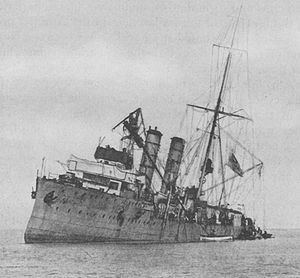2 armored cruisers damaged1 cruiser grounded27 dead and 49 wounded Minor damages Result Allied victory | Start date July 2, 1915 | |
 | ||
Similar World War I, Battle of Moon Sound, Battle of the Gulf of Riga, Battle of Penang, Battle of Dover Strait | ||
Battle of land islands
The Battle of Åland Islands, or the Battle of Gotland, which occurred in July 1915, was a naval battle of World War I between the German Empire and the Russian Empire, assisted by a submarine of the British Baltic Flotilla. It took place in the Baltic Sea off the shores of Gotland, Sweden, a country neutral in World War I.
Contents
The Battle
On 1 July [O.S. 18 June] 1915, a squadron consisting of the armored cruisers Admiral Makarov, Bayan, Oleg, Bogatyr, Rurik and Novik, under Rear Admiral Mikhail Bakhirev in Oleg left their harbours in order to bombard Klaipeda (Memel). While sailing through thick fog Rurik and Novik separated from the main group and later acted independently.
On the same day the German mine-laying cruiser SMS Albatross, screened by the armored cruiser SMS Roon, the light cruisers SMS Augsburg and Lübeck, and seven destroyers, under Kommodore Johannes von Karpf, was laying mines off the Åland Islands. After completing his mission, Karpf reported back through the radio. Karpf's message was intercepted and decoded. When Bakhirev became aware of the German squadron's whereabouts, the bombardment of Klaipeda was canceled. The squadron then focused on intercepting the German minelayers with the constant assistance of the naval staff.
In the early morning of 2 July [O.S. 19 June] 1915, the Russian squadron spotted and immediately opened fire on Augsburg, Albatross and three torpedo boats. Karpf commanded Roon and Lübeck, which at the time were heading towards Liepāja (Libau), to return to Gotland. At the same time he ordered Albatross to find shelter in Swedish territorial waters. Bogatyr and Oleg managed to catch up with Albatross and opened fire. The flaming Albatross ran aground on the island of Estergorn. Bayan, Oleg and Rurik then attempted to return to their base. A couple of hours later they encountered Roon and Lübeck. A short artillery duel followed. A shortage of shells forced the Russian cruisers to retreat. Fearing a possible arrival of enemy reinforcements the damaged German ships also retreated.
As the German armored cruisers SMS Prinz Adalbert and Prinz Heinrich sailed to reinforce the German squadron, Prinz Adalbert was torpedoed by the British submarine HMS E9 and limped to shore.
Legacy
The battle is regarded as the first instance of Russian signals intelligence.
